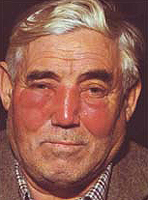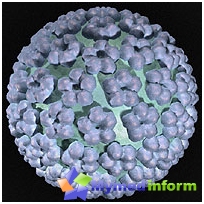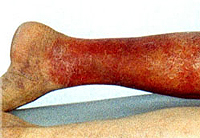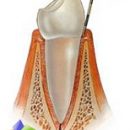What is Rozh? What are the symptoms and the course of faces? How is the treatment of faces? Answers to these questions you will find in the article.
Content
Rygin
Rigor skin inflammation, or face - general acute infectious disease
With phenomena of limited skin inflammation. The disease is prone to relapses, t.E.
to re-occurrence.
The causative agent of the disease is hemolytic streptococcus, less often the disease is called
Staphilococci. The source of infection is a sick person or a streptococcal carrier.
The pathogen falls into the thickness of the skin through scuffs, diameters, abrasions, scratches,
Combs, cracks, areas of fungal lesion and even through imperceptible violations
Her integrity. Often the pathogen is transferred to the patient himself if
His other streptococcal disease. Disease occurs only when reducing
The resistance of the body under the action of any adverse factors.
Women and elderly faces more often sick.
Rog relapses usually arise in the same place. This is due to the presence here
chronic disturbance of lymphatic outflow and development in this skin
increased sensitivity to the causative agent or maintaining it there in «Dormant»
condition. Non-sufficient and incorrect treatment contribute to recurrence.
Recurney, as a rule, arises without prior injury.
Immunity after the faces does not occur. On the contrary, increased sensitivity can develop
To Streptococcus.
As a rule, damaged skin is infected with streptococci infected. IN
Individual cases, the disease occurs and without disruption of the integrity of the cover.
Microbes enter the skin from people who are the source of gloty microbes,
or penetrate various paths (with blood flow, air-droplet, through
contact) from foci of their own body. In all cases, a prerequisite
For the occurrence of the disease is the presence of predisposition.
The impact of the causative agent during Roger is manifested by local and general changes
in the body. The local process is manifested by inflammation of the skin, accompanied by redness
and swelling of the affected skin and subcutaneous fiber. In the pathological process
Also involve lymphatic (lymphangitis), arterial (arteritis) and venous
(Flebit) vessels. The overall effect of streptococcal infections in Roger is manifested
Fever, intoxication, toxic damage in internal organs. Specifying
on lymphatic and blood vessels streptococci under certain conditions
can cause secondary purulent complications.
Symptoms and Frames
Symptoms and current: The incubation period lasts from several hours
up to 2-3 days. Usually the face begins sharp: the body temperature is rapidly rising
Up to 39-40 s, weakness, driers, pain in the muscles of the body and limbs appear,
Headache, nausea, sometimes vomiting.

In the area of the affected area of the skin, only itching appears, a feeling of burning.
After 10-24 hours, pain, the heat of heat appears, then red
stain that quickly, for several hours, by peripheral growth
Increases in size. The affected area of the skin of pink or bright red
Colors, has clear, but irregular edges in the form «Flame languages», Slightly towers.
With the defeat of the age, lips, genital organs, a pronounced edema is observed fingers.
The skin in the zone of inflammation is tense, hot and sharply painful when touched.
Rigor skin inflammation most often arises on the face in the area of the briefs of the nasal
holes, nasolabial folds, nose back, on one or both cheeks in the form
Butterflies, in the angles of the mouth and the external auditory passage, as well as on the pole
Head. Several less often is observed on the legs, even less often - in other areas.
It is possible to form small and large bubbles filled with transparent, purulent
or bloody content. Usually bubbles are bursting, the flowing fluid shanks
in crusts. After rejection, the crust is visible by young tender leather. The duration of feverish
The period ranges from 2 to 10 days and depends on the beginning of the treatment and severity of the disease.
Skin lesion is preserved for 5-15 days.
Pebble relapses can occur between several days to 2 years after the previous one
Diseases.
With frequent recurrences of risms, fever small within 1-2 days, well-being
the patient remains satisfactory, lesion of the skin in the form of individual non-labor
Spots without edema.
Complications: Possible appearance of purulent complications: abscesses, phlegmon,
Otitis, thrombophlebitis. With impaired lymphottock (with repeated diseases
Horn) develops elephantity, especially on the lower limbs.
Treatment of faces
In the acute period of the disease, and during the damage to the legs - throughout
The disease period is recommended bed. With severe disease,
The presence of concomitant diseases (diabetes mellitus, etc.), old age,
Frequent recurrences of the disease showing hospitalization.
Antibacterial drugs are prescribed (antibiotics), most effective
Penicillin group (benzylpenicillin sodium salt) can be used
Prolonged (long-term) preparations of Penicillin - Bicyllin, Retaren,
Extensively, better in the form of intramuscular injection at the end of the treatment of benzylpenicillin.
There are preparations of penicillin, intended for intake - ospen-750
Syrup, with allergies to penicillin, erythromycin, Sumamed, Zimax applied.
Sulfonamides and tetracycline in the treatment of faces do not apply, as they
Streptococci are not sensitive.
A rich drink is recommended in the fever. Antipyretic drugs
(Panadol, Tylenol, Calpol, Mexalene, Effergan-Oops) should be taken with
Temperature of body 39 C and higher. Reception of polyvitamins - peak,
Savorite, Vitrum, Multi-Tabs, Unicap, Rezit, etc.
Local procedures for rodes are not recommended. To improve wound healing (especially
When forming bubbles) Curizin is applied.
Prevention. Compliance with personal hygiene rules, treatment of fungal diseases
Skin.









